This list includes types of approaches that are helpful when using spatial statistics for descriptive methods in crime analysis:
- Clustering: Use methods such as nearest neighbor algorithms (hierarchical and nonhierarchical) and the k-means algorithm to identify and analyze criminal hot spots, to describe the properties of inter-incident distances, or to describe spatial autocorrelation that exists between dense areas of criminal activity.
Spatial autocorrelation is a term that refers to the natural phenomenon that when things are closer to one another in physical location, they exhibit more average similarity than things that are far away from one another.
- Advanced spatial mathematics: You can use spatial mathematical metrics, such as the Euclidian metric or the Manhattan metric (otherwise known as the taxicab metric) to describe the distances between criminal incidents or sets of incidents. The Euclidean metric is a measure of the distance between points plotted on a Euclidean plane. The taxicab metric is a measure of the distance between points, where distance is calculated as the sum of the absolute value of the differences between two points' Cartesian coordinates.
- Descriptive statistics: Use statistics to generate a description about the location distribution of criminal activities — including information on the directional mean and mean center of criminal incidents.

